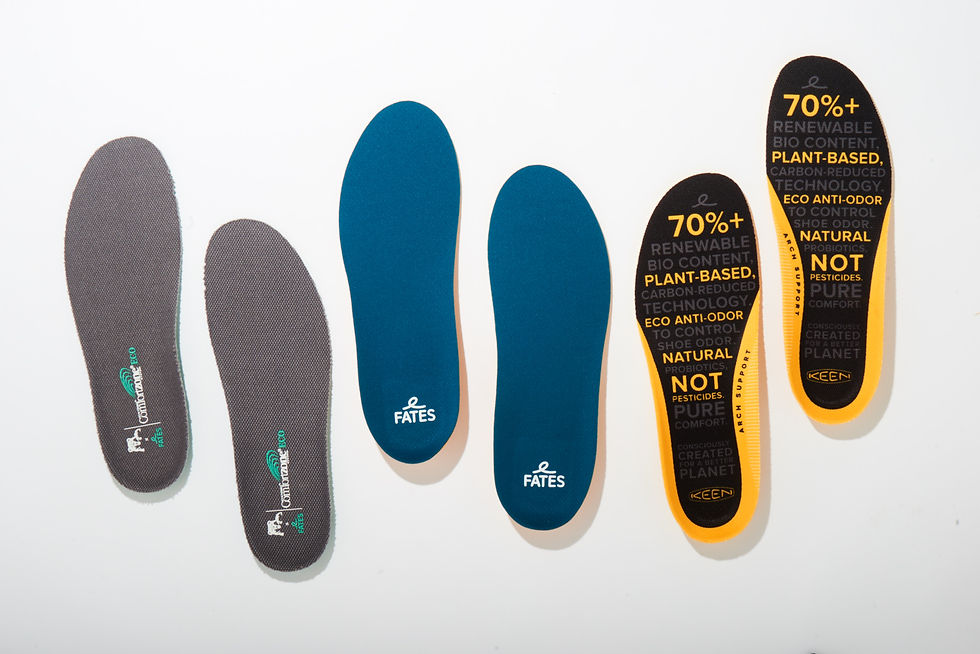FATES® Footwear: The Future Starts at the Source
- dranoelalex
- Jul 30
- 3 min read
Updated: Aug 6

Reimagining Footwear with Sustainable Raw Materials 🌽
From sneakers to sandals, every step we take leaves a footprint—not just on the ground, but on the planet. Footwear manufacturing contributes approximately 700 megatons of CO₂ equivalent greenhouse gas emissions annually, with up to 40% stemming from the raw material extraction and processing phase.[1]
To address this, we believe the future of footwear starts with the source: plant-based chemistry.
Unlocking the Power of the Bioeconomy in Footwear 👠
The bioeconomy is centered around using renewable, biological resources, like agricultural waste, forest by-products, and plant starches—to create everyday goods, including performance foams for footwear.
Bio-based materials offer a lower environmental impact compared to traditional oil-derived polymers. For brands looking to decarbonize their product lines, partnering with Evoco on manufacturing FATES footwear products will help businesses coming out the gates.

Why it matters for footwear: 👟
Plant-based materials reduce fossil fuel dependency
Measurable reductions in GHG emissions (up to 70% fewer emissions from raw materials using FATES®)
Opens the door for local sourcing and circularity
FATES®: Built for the Footwear of Tomorrow 🌆
FATES® is a high-performance, plant-based material technology engineered for a variety of footwear applications—from midsoles to insoles to slides and sandals.
It’s feedstock-agnostic, meaning it can be created using different regional biomass sources without compromising performance. This allows manufacturers to diversify sourcing, reduce transport emissions, and align with local regenerative practices.
Proven Performance:
Durable and resilient under heavy wear
Low compression set—maintains shape and support over time
Minimal water absorption (<1%, third-party tested)
High abrasion resistance, ideal for one-piece and exposed designs like slides and flip-flops
High bio-content for carbon footprint reduction
These properties make FATES® the ideal raw material for progressive footwear brands ready to scale sustainability without compromising on performance.
Our Feedstock Philosophy: From Field to Footwear 🌾
Our current FATES® formulations utilize field corn by-products, specifically, the non-edible, low-calorie starches leftover from food and feed processing. This ensures:
No competition with food supply
No redirection of arable land for non-food purposes
A use for waste that would otherwise go underutilized
Today, less than 0.1% of total arable land is used for biopolymer feedstocks.[3] Even a modest reallocation of agricultural waste could supply raw materials to replace all petrochemical plastics.[4]
![[3] European Bioplastics (2021), FAO Stats (2020), nova-Institute (2021) (featured in graphic above)](https://static.wixstatic.com/media/63d173_9cd26aa09ea64df69e6a46d9725b4f50~mv2.png/v1/fill/w_980,h_735,al_c,q_90,usm_0.66_1.00_0.01,enc_avif,quality_auto/63d173_9cd26aa09ea64df69e6a46d9725b4f50~mv2.png)
What’s Next for FATES® in Footwear?
Our vision is clear: adapt and evolve as new biomass sources become viable and sustainable. Future FATES® feedstocks may include:
Castor oil and nutshell oils
Lignin from forestry by-products
Algae and other second-generation waste streams
Each potential feedstock will be life-cycle analyzed to ensure that lower emissions and land-use impacts are maintained.

Walk Into the Future with FATES®
By integrating FATES® into your next footwear collection, you're not only enhancing material performance—you're part of a growing shift toward a low-carbon, bio-based future.
Whether you're developing sandals, slides, or lifestyle sneakers, FATES® is designed to perform at scale—from lab to lifestyle.
Interested in collaborating or sampling FATES® for your next footwear line?
Contact us at info@evocoltd.com or visit fates.ca/contact to reach our team for more information on starting a foam project in your commercial product today.
References[1] Quantis. (2018). Measuring Fashion Report [2] Lupton, M. (2017). Plant Matter vs Petrochemicals, AZoCleantech [3] European Bioplastics (2021), FAO Stats (2020), nova-Institute (2021) |[4] IFBB Hannover. Bioplastics vs Food Supply



Comments